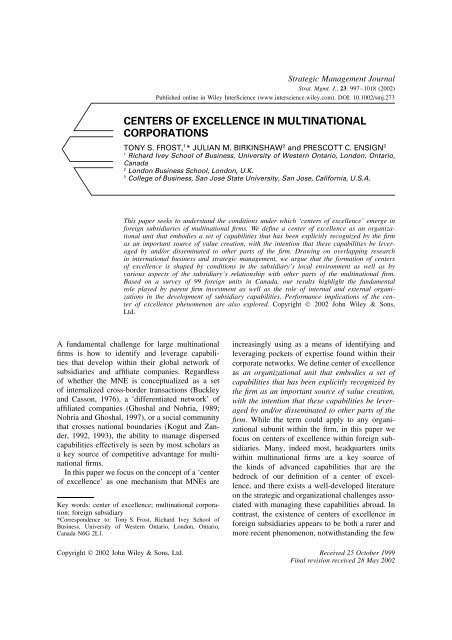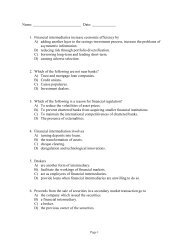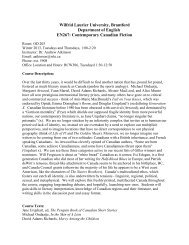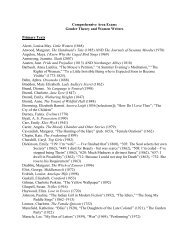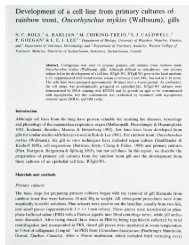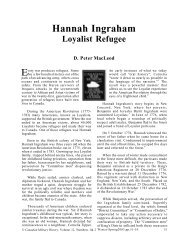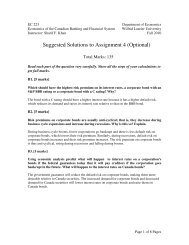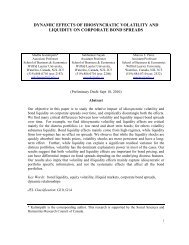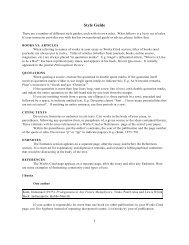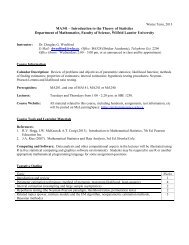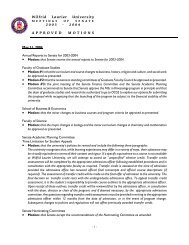CENTERS OF EXCELLENCE IN MULTINATIONAL CORPORATIONS
CENTERS OF EXCELLENCE IN MULTINATIONAL CORPORATIONS
CENTERS OF EXCELLENCE IN MULTINATIONAL CORPORATIONS
Create successful ePaper yourself
Turn your PDF publications into a flip-book with our unique Google optimized e-Paper software.
998 T. S. Frost, J. M. Birkinshaw and P. C. Ensignwell-known examples that have been frequentlycited in the literature. 1 As we will discuss shortly,the managerial challenges associated with developing,identifying, and leveraging centers of excellencein foreign subsidiaries are many and varied.These challenges—and the evident difficulty thatmany companies have in coping with them—arethe underlying motivation for this paper.The paper has three main goals: first, to reviewthe existing literature on the term ‘center of excellence’and to explain how our definition remediesthe major shortcomings in current usage; second,to advance a conceptual model and specific set ofhypotheses regarding the factors contributing to theemergence of centers of excellence in foreign subsidiaries;and third, to test the explanatory powerof our model and hypotheses using recently collectedsurvey data on 99 foreign-owned subsidiarycompanies in Canada.The remainder of the paper is structured as follows.We begin by discussing the center of excellenceconcept and providing examples of its usagein practice. This section concludes with our formaldefinition. We then develop our main theoreticalargument, drawing on overlapping research ininternational business and strategic management.In this section we formulate a set of hypothesesabout the factors that are likely to give rise to centersof excellence in multinational firms. The nextsection discusses research methods, including ourdata collection strategy and variable operationalizations.We then present the results of our hypothesistests and, in a more exploratory vein, investigatethe performance consequences of the centerof excellence phenomenon. Finally, the paperconcludes with a discussion of the contributionand limitations of the study and suggests severalavenues for future research.<strong>CENTERS</strong> <strong>OF</strong> <strong>EXCELLENCE</strong> <strong>IN</strong>MULT<strong>IN</strong>ATIONAL FIRMSTo ground our discussion and subsequent definitionof the center of excellence concept, we begin byoffering the following case examples culled from1 Well-known examples include Fuji Xerox, Nestlé’s headquartersfor its confectionery business in England, GE’s power systemsbusiness in Canada, and Volvo’s manufacturing operationin Belgium. Often such centers of excellence have arisen throughacquisitions of foreign firms rather than through active cultivationby the parent firm.an extensive search of the practitioner literature aswell as our own case research:• Merck Frosst Canada, the Canadian subsidiaryof Merck & Co., is a center of excellencefor drug discovery in the area of leukotrienes.Although the subsidiary also has a broad set ofresponsibilities in terms of manufacturing, salesand distribution, it has gained primary responsibilitywithin the company for leukotrieneresearch, and has developed several major productsthat are now sold by Merck & Co.worldwide. Interestingly, the subsidiary’s mostrecently developed product in its area of specializationis not manufactured in Canada, butrather at the company’s Irish subsidiary, itselfa center of excellence for the manufacture ofethical pharmaceuticals.• Philips established a Center of Competence inLe Mans for its communications terminals business.This center became the business headquartersfor cordless phones, smart cards, pagingand fax terminals. It drew on its own specializedexpertise in communication terminologyand also the expertise of the rest of the Philipsgroup worldwide (Bright, 1996).• Hewlett Packard has a ‘center of manufacturingexpertise’ in Singapore that is responsible formanaging the migration of lower value-addedactivities out of Singapore into low-cost regionsin China and South East Asia. At the sametime, the Singapore subsidiary has been grantedthe worldwide mandate to develop, produce,and market all of HP’s handheld informationproducts, including mobile printers, calculators,and palmtop organizers (Leonard-Barton, 1995).• ITT Fluid Technology Corp. created severalcenters of excellence in the Information Technologyarea. Technical staff remained in theirlocal offices performing functions such as LANadministration, but in addition several becamecompany-wide experts in specific technologies.Staff anywhere can now call on these expertsfor assistance in their specific areas of expertise.This arrangement, according to the CIO, ‘is theideal balance between the efficiency of centralizedresources and the high-touch relationshipsthat are only possible when technical staffersstay in business units’ (Liebmann, 1996).• IBM has established a number of centers ofexcellence in key technology areas. For example,the newly created Intelligent Agent centerCopyright © 2002 John Wiley & Sons, Ltd. Strat. Mgmt. J., 23: 997–1018 (2002)
1000 T. S. Frost, J. M. Birkinshaw and P. C. Ensigndiscussed above, it is a mistake to equate centersof excellence with subsidiaries on a one-foronebasis, especially given the advanced globalconfigurations adopted by many of today’s leadingMNEs. Second, centers of excellence representa focus for a superior set of capabilitieswithin the firm, including tangible resources suchas equipment, licenses, and patents, and intangibleresources such as knowledge and experience. 2As such, a center of excellence is probably bestdefined in terms of its basis for creating valuerather than in terms of a specific product or lineof business, especially given that many centers ofexcellence possess fungible capabilities, i.e., capabilitiesthat are able to create value for more thanone line of business (e.g., ITT’s information technologycenters). Third, a center of excellence isexplicitly recognized or declared as such by thecorporation. This is important if the term is tomean something other than a particular unit is‘excellent’ at a particular activity or practice. Andfinally, the pronouncement that a particular unit isa center of excellence in a particular activity ordomain implies the intention to derive value fromthat unit’s capabilities for the broader organization,through, for example, the development of productsand technologies that can be sold throughout thefirm’s global sales network, or through the diffusionof intangible assets (knowledge, learning) toother organizational units. These dimensions suggestthe following definition:A center of excellence is an organizational unitthat embodies a set of capabilities that has beenexplicitly recognized by the firm as an importantsource of value creation, with the intention that2 The above discussion raises the question as to whether a particularorganizational subunit needs to have unique capabilities inorder for it to qualify as a center of excellence. In our opinion,uniqueness is not a requirement. Our fieldwork clearly indicatedthat there were many examples of companies that had establishedseveral centers of excellence within the company that werevery similar in terms of capabilities and mandate, in some casesidentical. Intel, for example, has several leading-edge fabricationplants around the world at which the latest microprocessorsare being built. These are clearly centers of excellence by ourdefinition, but they also have to have the same key capabilitiesbecause of Intel’s ‘copy exactly’ manufacturing model. Merckis another example of a company that has several manufacturingcenters of excellence spread throughout the world with verysimilar capabilities. For many companies, this apparent redundancyis purposive and strategic, as it allows the company toshift production in response to need and opportunity (e.g., e-ratefluctuations), and it engenders both learning and competitionwithin the network.these capabilities be leveraged by and/or disseminatedto other parts of the firm.DETERM<strong>IN</strong>ANTS <strong>OF</strong> <strong>CENTERS</strong> <strong>OF</strong><strong>EXCELLENCE</strong> FORMATIONHaving advanced our definition of the term centerof excellence, we are now in a position to explorethe conditions under which they are likely to becreated in multinational firms. This issue is concernedfundamentally with the development andrecognition of advanced capabilities that provide asource of value beyond the boundaries of the originatingunit, i.e., within the multinational’s globalnetwork of activities. Thus the research questionwe are concerned with is the following: Underwhat conditions do foreign subsidiaries develop aset of advanced capabilities that are recognized bythe parent as an important source of value creationfor the firm?Our overarching argument is that the formationof centers of excellence is influenced by conditionsin the subsidiary’s local environment as wellas by various aspects of the subsidiary’s relationshipwith other parts of the multinational firm.Figure 1 provides an overview of our conceptualmodel. External factors concern the extent towhich the subsidiary is embedded in a dynamicmarket and institutional context and is connectedto key sources of competence within that context.Internal factors include, most fundamentally,capability-building investments made by the parentfirm, as well as organizational conditions such asthe autonomy of the subsidiary and its connectivityto important sources of competence within thefirm. Performance in our model is endogenous: thesuperior capabilities and the greater-than-unit locusof exploitation for these capabilities drive positiveperformance on several possible dimensions,including profitability, competitiveness, innovation,and learning. But performance, in turn, influencesthe center of excellence formation process,most fundamentally by inducing greater levels ofparent firm investment in the unit. In the remainderof this section we flesh out this frameworkby drawing on overlapping literature in internationalbusiness and strategic management. Wealso generate a set of hypotheses that are subsequentlytested in the empirical portion of thepaper.Copyright © 2002 John Wiley & Sons, Ltd. Strat. Mgmt. J., 23: 997–1018 (2002)
Centers of Excellence in Multinational Corporations 1001External Factors• Strength of local “diamond” (H1)• Links to sources of competence (H2)Center of Excellence• Strong capabilities• Formal recognition• Greater than unit level contributionPerformance• Profitability and competitiveness• Innovation• Learning and knowledge transferInter-unit Relationships• Links to sources of competence (H3)• Subsidiary autonomy (H5)Parent FirmInvestment (H4)Figure 1.Conceptual model of center of excellence formation in multinational firmsExternal factorsScholars have long recognized that location (andall that term implies) is important to the developmentof firm-level capabilities and competitiveadvantage (Marshall, 1920; Kogut, 1991; Porter,1990). At a macro level, differences across countriesin terms of endowments and institutionalconditions play out in enduring patterns of internationaltrade. At more micro levels, the dominanceof particular firms—and clusters of firms—in certainindustries can be attributed, in part, to theinstitutional conditions in which these firms areborn and evolve. Porter’s (1990) diamond modelis perhaps the most complete articulation of thisperspective to date and has led to a renaissance ofinterest in the relationship between geography andfirm-level competitive advantage.Applied to a global strategy context, the mostbasic insight of this work is that the multinationalenterprise is a firm-level manifestation ofhome country competitive advantage. In essence,this is the classical view of the multinationalfirm: the headquarters organization, responding tolocal stimuli (e.g., customers, competitors, suppliers)generates innovations, including organizationalcapabilities, that then find application andsuccess in international markets. A more recentstream of research has extended this perspective toinclude the possibility that the institutional diversitythat is inherent in the border-crossing processof global strategy may actually provide opportunitiesto create new sources of competitive advantage.As Frost (2001: 101) notes:a potentially important source of competitive advantagefor multinational firms is the capacity oftheir foreign subsidiaries to generate innovationsbased on stimuli and resources resident in theheterogeneous host country environments in whichthey operate.Although empirical work in this emergingresearch stream has been slow to develop dueprimarily to data limitations, a recent wave ofresearch has highlighted the importance of the hostcountry to the subsidiary development process. Forexample, Kogut and Chang (1991) and Anand andKogut (1997) provide evidence at an industry levelthat foreign investment may be motivated, in part,by the ‘pull’ of skills and capabilities resident inthe host country. Case study research bears thisargument out as well, especially in studies thathave focused on the motivation for and role offoreign R&D in multinational firms. Florida andKenney (1994), Kim (1997), Kummerle (1996),and Westney (1992) all provide examples thatsubsidiaries assimilate knowledge from their localenvironment. Frost’s (2001) larger sample workdrawing on patent citation analysis finds thatCopyright © 2002 John Wiley & Sons, Ltd. Strat. Mgmt. J., 23: 997–1018 (2002)
1002 T. S. Frost, J. M. Birkinshaw and P. C. Ensignareas of technological specialization in foreignsubsidiaries are underpinned by ideas that originatein the subsidiary’s immediate geographic locale.A closer look at this line of inquiry reveals twodistinct, albeit related arguments. The first, typicallycast at the country or regional level, looks atthe strength and dynamism of a particular locationas providing a ‘latent’ opportunity for multinationalfirms to derive a learning benefit from thatlocation. Fundamentally, this is an argument aboutlocational advantage—the strength of the industry‘diamond’ in a particular location, to use Porter’s(1990) terminology.The second argument is a subsidiary-level argumentand points to the connectivity of the unitto key actors and resources in the host country.In this view, competence development is facilitatedby active participation of the subsidiary inthe ‘community of practice’ that structures activityand relationships in a particular area (Powell,Koput and Smith-Doerr, 1996). Local customersmay influence the path of subsidiary capabilitydevelopment through a stringent set of needs, aswas the case with the Canadian subsidiary ofBritain’s ICI, which became a center of excellencefor explosives due, in part, to the demandingusage requirements of the Canadian miningindustry. Researchers have noted a similar rolefor suppliers, especially in facilitating the adoptionof innovations by downstream organizations(Dosi, 1988). Competitors, too, may stimulatethe process of competence development throughdirect (e.g., alliances) or indirect (e.g., mimicry)means, as noted frequently by Porter (1990).From these arguments, we derive our first twohypotheses:Hypothesis 1: The greater the strength anddynamism of the local industry ‘diamond,’ themore likely is the subsidiary to contain a centerof excellence.Hypothesis 2: The greater the impact of externalorganizations on the development of a subsidiary’scompetence, the more likely it is tocontain a center of excellence.It is important to recognize that the above argumentsare not in any sense deterministic. Thatis, we are not saying that a strong industry diamondin the host country guarantees the formationof a center of excellence in a subsidiary basedthere. Rather, our point is that, all else equal, astrong industry diamond increases the likelihoodthat a subsidiary based there will form a center ofexcellence. These factors, then, need to be seen ascontributory, as empirical evidence suggests theymay not be necessary or sufficient. For example,many multinationals have ‘scanning units’ (Vernon,1979) in dynamic environments whose role isto pick up and transfer knowledge back to corporateheadquarters, rather than develop strong capabilitiesthemselves. Equally, there are some casesof centers of excellence emerging in locations thatare not particularly dynamic and where externallinkages are weak, such as Monsanto’s manufacturingcenter in Morden, Manitoba (Birkinshaw,1995). As in most of the issues studied by strategyresearchers, outcomes are subject to manyand varied forces, as is suggested in our model,which we believe is the most parsimonious wayof explaining what is in practice a very complexphenomenon.Internal factorsIn addition to the external factors discussed above,our model also highlights the importance of factorswithin the boundaries of the multinational firmthat play an important role in the formation ofcenters of excellence. Consider first the relationshipof the foreign subsidiary to the parent firm.Nohria and Ghoshal (1997) suggest that the multinationalenterprise can be modeled as a ‘differentiatednetwork,’ in which the foreign subsidiary isconnected not only to the headquarters of the parentfirm but also to other subsidiary units aroundthe world. These network linkages make it easierfor foreign subsidiary units to coordinate theiractivities on a worldwide basis, but they also representan important source of intangible knowledgeflows. If, for example, the subsidiary is sellingto another business unit within the multinationalnetwork, the relationship with that customer canbe an important source of ideas about how toimprove its product offering. Equally, in workingwith an R&D unit in another country, thatrelationship can also be the seeds of a new productthat results in the development of the foreignsubsidiary. The argument, in other words, is thatinternal network linkages can work in a very similarway to relationships in the local market, i.e.,by stimulating the emergence of new ideas andCopyright © 2002 John Wiley & Sons, Ltd. Strat. Mgmt. J., 23: 997–1018 (2002)
Centers of Excellence in Multinational Corporations 1003fostering the emergence of advanced capabilitiesin the subsidiary. 3Hypothesis 3: The greater the impact of otherunits within the multinational network on thedevelopment of a subsidiary’s competence, themore likely it is to contain a center of excellence.The preceding discussion highlighted the role ofthe parent firm as a provider of important intangibleassets (skills, knowledge, expertise) that a subsidiarycan draw upon to develop its own capabilitybase. But a more fundamental role of the parentfirm is typically as a provider of tangible resources,especially investment capital, needed by the subsidiaryto develop the kind of advanced capabilitiesthat may give rise to its eventual recognition as acenter of excellence. Indeed, Birkinshaw and Hood(1998) identify parent-driven investment (PDI)as one of the classic processes through whichsubsidiaries develop capabilities that subsequentlyform the basis for an expanded role within thecompany. This claim is also supported by the moremainstream literature in strategic management onthe process of capability development and strategicdecision making. Dierickx and Cool (1989) andBarney (1991), for example, note the importanceof sustained investment over time to the developmentof capabilities and positions that are likely tolead to competitive advantage. Similarly, Burgelman(1996) and others (e.g., Galunic and Eisenhardt,1996; Noda and Bower, 1996) argue thatstrategic decision making, especially concerningthe capabilities needed to enter new businesses,can be understood as ‘as an iterated process ofresource allocation’ (Noda and Bower, 1996: 159).In this spirit we propose:Hypothesis 4: The greater the investment madeby the parent firm in the subsidiary, the morelikely it is to contain a center of excellence.Although investment may be a precondition for thedevelopment of advanced capabilities as suggested3 Note that this is in some ways a mirror-image of the processby which the center of excellence leverages its capabilitiesthroughout the multinational corporation. However, the two processesare distinct, because in the first the center of excellenceis the receiver of knowledge and in the second it is the sender(Szulanski, 1996). Also, one will often see the center of excellencedevelop its expertise through one set of relationships (e.g.,a sister plant or HQ) and then apply that expertise in otherrelationships.by our fourth hypothesis, it is also clear that thedecision by the parent firm to invest in a particularsubsidiary’s development is endogenous—i.e., it isat least partly determined by preexisting capabilitiesof the subsidiary, by preexisting commitmentsby the parent to the subsidiary’s position as a centerof excellence within the firm (in the form ofpast investments and explicit recognition, perhaps),and by outcomes. Subsidiaries that perform wellin their role as a center of excellence can expectto be rewarded by the parent firm in the form ofadditional investment and, perhaps, an expansionof their charter. The HP Singapore case noted earlieris a classic example of the positive feedbackloops running from parent investment to capabilitydevelopment to subsidiary performance to charterextension to more parent investment (Leonard-Barton, 1995). In this sense the formation of centersof excellence in multinational firms can beunderstood as a cumulative, evolutionary process.We return to this point later in the discussion.The other classic subsidiary development processidentified by Birkinshaw and Hood (1998),which they term subsidiary-driven charter extension(SDE), also involves the parent firm. However,in this case, the role of the parent is moreof a sanctioning body, granting a subsidiary witha preexisting set of advanced capabilities the rightto pursue a new or extended charter. In this sense,the SDE process actually requires the foreign subsidiaryto have considerable autonomy in terms ofthe ability to identify and pursue interesting marketopportunities without explicit permission from theparent company. The link between autonomy andthe development of centers of excellence is supportedby early work in the Canadian context byCrookell (1986) as well as by more recent researchby Birkinshaw (1997). Hence our final hypothesis:Hypothesis 5: The greater the autonomy of thesubsidiary, the more likely it is to contain acenter of excellence.METHODData collectionThis paper is part of a larger project on centers ofexcellence in multinational firms conducted by ateam of researchers in eight countries, all of whomused a similar survey instrument. In the course ofCopyright © 2002 John Wiley & Sons, Ltd. Strat. Mgmt. J., 23: 997–1018 (2002)
1004 T. S. Frost, J. M. Birkinshaw and P. C. Ensigndeveloping the instrument, the research team meton four occasions. The first meeting defined theobjective of the questionnaire. Subsequent meetingswere used to more carefully define the coreconstructs and then the wording of specific items.We also made use of existing scales from previousstudies. Finally, after the second iteration of thesurvey instrument we pilot tested it using a numberof executives from one multinational company.The net result was a carefully crafted instrumentthat had been subjected to three rounds of revision,pilot testing, and the opinions of eight researchersworkinginthefield.This study focuses on Canada, which is in manyways an ideal context in which to explore thecenter of excellence concept. First, the Canadianeconomy is characterized by a high level of foreignownership of industry, a feature that has longdistinguished it from other advanced industrialnations. In addition to obvious advantages in termsof convenience, this feature of the Canadian economymakes it likely that the center of excellencephenomenon is more evolved in Canada than inmany other countries. Findings from the Canadianexperience are thus likely to presage experiencein other countries where FDI has more recentlybecome a major part of the institutional landscape.Second, the 1989 Free Trade Agreement betweenCanada and the United States resulted in a considerableamount of restructuring of foreign-ownedactivities in Canada, with some being terminated ortransferred to other locations and others receivinggreater investment. We believe that this restructuringprocess has led many foreign firms operating inCanada to articulate explicitly their goals and rationalefor developing (or not developing) centersof excellence within their Canadian subsidiaries.Again, this suggests that the Canadian experienceis likely to be on the leading edge of developmentselsewhere. And finally, because Canada is adeveloped country with many advanced factors ofproduction, it provides a good location for exploringthe linkage between the characteristics of thehost country and the development by foreign subsidiariesof the kind of value-creating capabilitiesthat are central to our understanding of the centerof excellence phenomenon.We developed a list of 780 foreign-owned(greater than 50% of equity) companies in Canadawith annual sales of greater than $25 million.The mailing list was developed using wellestablishedsources such as the Financial Post1000, The Globe and Mail 500, and variousonline directories. Although some companiesdeliberately exclude themselves from such listings,our research suggests that this mailing list includesmore than 90 percent of the population.To give the study additional focus, the780 foreign-owned companies were drawn fromCanada’s manufacturing sector. Service sectorfirms were thus excluded from the sampling frame.This choice was driven by both practical andmethodological considerations. On the practicalside, the focus on manufacturing firms reducedconsiderably the cost of administering the survey.Two methodological considerations influencedour decision to focus on the manufacturingsector. First, because the center of excellence‘phenomenon’ is still not well understood, webelieved that it was important to pay primaryattention to matters of internal validity rather thanexternal validity. Many researchers have notedimportant differences between manufacturing andservice sector multinationals—differences that webelieve are likely to impact the processes by whichcenters of excellence emerge and are subsequentlyleveraged by the firm. Combining both sectorsin the same study risked a marginal gain ingeneralizability for a potential serious cost in termsof internal validity. Second, because our definitionof a center of excellence is cast at the subunitlevel (i.e., at the level of a function or activity), webelieved it would be wise to focus initial researchattention on two primary activities—R&D andmanufacturing—where centers of excellenceappear particularly likely to emerge. For servicesector firms, it is much less clear (in termsof activities) where centers of excellence arelikely to develop.The questionnaire was mailed to the CEOs of the780 foreign-owned firms in late 1997. In decidingupon the CEO as our target respondent, wefaced both theoretical and practical issues. Onthe one hand, our conceptualization of a centerof excellence pushed us to consider respondentsat lower levels in the subsidiary, ideallymore than one per organization. We ruled out thisapproach primarily for practical reasons relatingto the difficulty of obtaining the necessary contactinformation, and cost. Instead, we chose a singlerespondent—the CEO—but structured our instrumentsuch that key questions were very explicitlyfocused around functional areas, i.e., belowCopyright © 2002 John Wiley & Sons, Ltd. Strat. Mgmt. J., 23: 997–1018 (2002)
Centers of Excellence in Multinational Corporations 1005the overall organizational level. As discussed earlier,this functional level focus is consistent withour conceptual approach and with our observationsfrom the field about where and how centersof excellence develop. The specific choice ofthe CEO as our target respondent follows traditionalpractice and was intended to ensure that therespondent had a sufficient breadth of knowledgeabout all of the major facets of the organization,its activities, and environment.Following the recommendations on survey protocolcontained in Dillman (1978), we followed upon our first mailing with a reminder letter. Afterthis follow-up, a total of 99 questionnaires werereturned in usable form, giving us a response rateof 13 percent. This is not as high a response rate aswe would have liked, but it is well within the normalrange for surveys of multinational subsidiaries(Harzing, 1997).Data and measuresThe data used in this study came primarily from thequestionnaire. 4 Most items were measured using1–7 Likert-type scales. Some, such as the numberof employees and the percentage of foreign sales,were measured using actual values. In addition, weconducted field interviews in five subsidiary companies.The data collected during these interviewswere used to formulate the theoretical frameworkand, subsequently, to help make sense of the resultswhen they did not always correspond to our predictions.Centers of excellenceRecall that our definition of the term is composedof three main elements: strong capabilities, formalrecognition, and greater-than-unit level contribution.Our survey contained questions designed tooperationalize all three elements. First, we askedrespondents to indicate their organization’s competencelevel in (1) research, (2) development, and(3) manufacturing using a 7-point scale, where1 was defined as ‘weak competence’ and 7 wasdefined as ‘very strong competence.’ 5 We chose a4 The complete questionnaire can be downloaded in PDF formatfrom the lead author’s home page: http://live1.ivey.uwo.ca/faculty/TonyFrost.html.5 Note that we chose to use an absolute scale, not a relative scale,in operationalizing strong capabilities. This was driven by ourscore of 4 as our cut-off point for defining strongcompetence. This seemed to us a reasonable levelas a first approximation, and the distribution ofresponses bore this out. However, as discussedbelow, we experimented with alternative cut-pointsas a way of assessing the robustness of our results.Second, for each activity we asked respondents toindicate whether ‘Our competence is formally recognizedby the headquarters’ (1 = yes, 0 = no).Finally, we asked the respondents to provide anindication of the extent to which their capabilitiesimpact other units. Our fieldwork suggested thatthe impact on other units can take many potentialforms, and that there is not a uniform hierarchy ofimportance. Thus we chose to frame our questionon impact in purposively broad terms. For each ofthe three functional activities, we asked: ‘To whatextent are the subsidiary’s distinctive competencesin [Research, Development, Manufacturing] of usefor other units in the Corporation?’ As above, weused a 7-point scale, where 1 indicated ‘No use forother units at all’ and 7 indicated ‘Very useful forother units’.In summary, we operationalized a center ofexcellence as a dichotomous variable based onrespondents’ answers to all three of the questionsnoted above. Only those units that met all threecriteria were classified as centers of excellencefor the purposes of our subsequent analysis. Thedichotomous nature of our variable seems to usto capture the essence of the center of excellenceconstruct as used in practice, although we recognizethat it may also be valid to conceptualize themin terms of degree, i.e., as a continuous variable.With this in mind we explored several alternativeoperationalization strategies as a way of checkingthe robustness of our initial findings. We discussthese and other interventions in a separate sectionfollowing the main presentation of results.qualitative work, which suggested that managers think simultaneouslyabout their unit’s capabilities in relative (to other unitswithin the firm and other firms) and absolute terms. Especiallyin manufacturing activities, it is apparent that many managerswould characterize their capabilities as being very strong in absoluteterms, but essentially on a par with local competitors andmany other units within the firm. Merck’s Canadian subsidiaryhas world-class capabilities in the manufacture of ethical pharmaceuticals—butsimilar to several other units within Merckand, indeed, similar to the operations of many of the world’sleading pharmaceutical firms. Our concern was that if we focusedthe question around comparative or relative ability, we wouldmiss many centers of excellence that have this kind of profile,i.e., multiple centers with similar capabilities worldwide.Copyright © 2002 John Wiley & Sons, Ltd. Strat. Mgmt. J., 23: 997–1018 (2002)
1006 T. S. Frost, J. M. Birkinshaw and P. C. EnsignTable 1.Centers of excellence: activities, competence, recognition and use to othersActivity A B C D EUndertakes Strong Formal A + B + C D+ UseActivity Competence Recognition to OthersResearch 45.3 35.8 20.0 18.9 17.9Development 68.4 63.2 33.7 33.7 26.3Manufacturing 93.7 91.6 70.5 70.5 51.6Any of the above 100.0% 92.6% 74.7% 74.7% 58.9%Because the center of excellence phenomenonis not yet well understood, it is worthwhile providingsome sense of the distribution of responsesto these questions—and thus the distribution ofcenters of excellence among Canadian subsidiariesin each of the three functional areas. Table 1 providesan overview. Column A begins by showingthe distribution of research, development, andmanufacturing activities across respondent units.Column A was derived from our questionnaire,which asked respondents to indicate which valueaddingactivities their unit engaged in. Whereasnearly all units reported undertaking some manufacturingactivity, less than half reported undertakingresearch activities. Using a cut-off point of4 out of 7 to define ‘strong competence,’ ColumnB shows that the distribution of such capabilitiesacross functional activities is even moreskewed toward manufacturing. Fully 91.6 percentof all respondents rated themselves 4 or higher interms of manufacturing capabilities, whereas only35.8 percent of respondents rated their researchcapabilities at that level. Development was in themiddle, at 63.2 percent.Column C shows the distribution of formalrecognition of the unit’s competence by headquartersacross the three functional activities. Formalrecognition turns out to be even rarer thanstrong competence, as evidenced by the consistentlylower numbers in Column C than in ColumnB. Somewhat surprisingly, three-quarters ofall of the units surveyed indicated that they hadat least one functional area where their competencewas formally recognized by headquarters.However, in Column E, this number drops considerablyonce we add the last criterion from ourdefinition, namely that to be considered a centerof excellence a unit’s capabilities must createvalue beyond its own boundaries, i.e., in thebroader corporation. Thus, only 18.9 percent ofrespondents indicated that their unit (1) possessedstrong capabilities in research, (2) had those capabilitiesformally recognized by headquarters, and(3) considered their capabilities to be of significantuse to other units in the corporation. 6 These unitsare centers of excellence (in research), accordingto our definition. The corresponding numbers fordevelopment and manufacturing were 26.3 percentand 51.6 percent respectively. Although themanufacturing percentage seems quite high, webelieve that this number is reasonable based onour understanding of the Canadian context and themajor role played by foreign companies in thatcountry. Especially in the post-NAFTA context,many multinationals have looked to their Canadiansubsidiaries as platforms for regional productionstrategies—and have made correspondinglysignificant investments in manufacturing capabilitiesand capacity. We suspect that these numberswould be lower in most other contexts, althoughwe defer this and other questions of generalizabilityto future research.External environmentBuilding on the main elements of Porter’s (1990)diamond model, and the scale developed by Birkinshawet al. (1998), respondents were asked toassess the business environment in which theycompete along four dimensions: availability ofsupply material; quality of suppliers; demandingcustomers; level of competition (1 = very low,7 = very high). Ideally, we would have been ableto use individual measures in our models. However,the high intercorrelation between many ofthe items motivated us to construct a compositeindex. Diamond Strength is calculated as the sumof the scores across these four items.6We adopted a cut-off point of 4 out of 7 for establishing that aparticular unit contributed to the broader organization.Copyright © 2002 John Wiley & Sons, Ltd. Strat. Mgmt. J., 23: 997–1018 (2002)
Centers of Excellence in Multinational Corporations 1007External sources of competenceThis construct was measured by asking respondentsto assess the impact of various organizationsoutside the boundaries of the firm on the developmentof the subsidiary’s competencies, where1 = no impact at all, 7 = very decisive impact. Wechose to focus the questions specifically aroundthe issue of competence development rather thana more general ‘strength of ties’ conceptualizationin order to avoid ambiguity in the interpretationof the results. Our fieldwork suggestedthat many subsidiaries would characterize themselvesas having strong ties (depth and breadth)to, say, a particular customer or supplier—withoutthose ties necessarily impacting the developmentof the subsidiary’s capabilities. In other words,many—probably most—interorganizational relationshipsappear to be geared toward the exploitationof existing capabilities rather than the developmentof new ones. We identified four externalorganizations that the existing literature andour own fieldwork suggest were potentially importantsources of competence development in foreignsubsidiaries: customers, suppliers, competitors, andexternal research institutions. In the models usedto test our hypotheses we use a composite measure,External Influence, based on the sum of theresponses across the four actors.Internal sources of competenceThe measurement of this construct mirrored theone above. Four specific organizations wereidentified (foreign corporate headquarters, specificinternal corporate customer, specific internalcorporate supplier, specific corporate R&D unit)and respondents assessed their impact on thedevelopment of the subsidiary’s competence,where 1 = no impact at all, 7 = very decisiveimpact. Our measure, Internal Influence,isthesumof the individual scores.Parent firm investmentFor each of research, development, and manufacturing,respondents were asked to ‘describe thelevel of investment in the Canadian Subsidiaryfor the past 3 years’ (1 = very limited, 7 = verylarge). We chose a 3-year time frame to eliminatesingle-year fluctuations and anomalies. Unfortunately,many surveys were returned with missingvalues on this question, potentially underminingits use in our statistical analysis. However, subsequentanalysis of the data indicated that thecause of the missing values was the absence ofa zero anchor, i.e., a ‘no investment’ category.This was confirmed by cross-tabulations, whichrevealed that surveys with missing values for thelevel of investment question were overwhelminglythose in which the respondent also checked ‘NA’for any activity in that area. Hence, we interpreteda missing value as indicating little or no investmentin that activity and recoded these values as 1. Ourresulting measure, Investment Level, is therefore anactivity-specific measure of parent firm investmentin the subunit, ranging from 1 to 7.AutonomyBased on the scale developed by Roth and Morrison(1992), respondents were asked to identifythe level at which certain decisions were made,where 1 = subsidiary level, 2 = subcorporate, 3 =foreign corporate HQ). Decisions were as follows:hiring top subsidiary management; enteringnew markets within the country; entering foreignmarkets; changes to subsidiary organization;introduction of new products/services; approval ofquarterly plans/schedules. Our measure, DecisionMaking Autonomy, is based on the average of thesesix items (alpha = 0.63).ControlsThe multinational literature suggests several factorsthat might be correlated with the formation ofcenters of excellence, but which are not causallyrelated to or even essential to the subsidiary developmentprocess. In particular, we expect that largerand more established (i.e., older) subsidiaries willbe more likely to contain centers of excellence.Both variables find some evidence in the previousempirical research on the evolution of foreign subsidiariesin multinational firms (e.g., Birkinshaw,1997; Frost, 2001; Ronstadt, 1977). To control forsize, we used the unit’s sales revenue in 1997,which was one of the items on our questionnaire.The age of the unit was similarly obtained fromthe questionnaire.A final factor that we considered important tocontrol for was the entry mode of the foreignunit. For example, research by Eun, Kolodny, andScheraga (1996), Harris and Ravenscraft (1991),Copyright © 2002 John Wiley & Sons, Ltd. Strat. Mgmt. J., 23: 997–1018 (2002)
1008 T. S. Frost, J. M. Birkinshaw and P. C. Ensignand Capron, Dussauge, and Mitchell (1998) hashighlighted the role of technological assets ofacquiring and target firms. Acquisitions may beparticularly favored when the capabilities of thetarget firm would be difficult to develop internally(for example, where intangibles are key) and whenthe acquiring firm has few technological capabilitiesof their own (Granstrand and Sjölander, 1990).Based on field interviews and our general knowledgeof the Canadian context, we do not havea strong prediction about the role of entry modein the development of centers of excellence. Wehave seen centers of excellence in units establishedthrough greenfield investment and acquisition.However, to ensure that entry mode is notdriving our results, we controlled for it by creatinga dummy variable that takes on the value of1 if the unit was established through greenfieldinvestment, and 0 otherwise.RESULTSWe begin by presenting descriptive statistics oncenters of excellence in each of the three functionalareas. These are presented in Table 2. In addition,we provide a set of comparison points with thoseunits that do not meet our three element definitionof a center (‘non-centers’ in Table 2). Thesestatistics reveal interesting differences across thethree types of centers of excellence as well as substantialdifferences between centers (of any kind)and non-centers. In terms of size, manufacturingcenters are the largest, with average sales in1997 of over C $300 million compared to lessthan C $100 million for both research and developmentcenters. Non-centers are in the middle atC $179.2 million. A similar pattern is reflected inthe number of employees, with manufacturing centersaveraging 774 employees compared to 436 and404 for research and development centers, respectively.Non-centers were again in the middle at 558employees, on average. Research and developmentcenters are also younger (19 years and 27 yearsold, on average, respectively) and more likely to beformed within an acquired subsidiary than a greenfieldsubsidiary. This finding accords with recentwork in strategic management on internationalacquisitions that has highlighted the importanceof technology-seeking motivations for cross-borderM&A (Capron et al., 1998; Inkpen, Sundaram andRockwood, 2000; Teece, 1992). Manufacturingcenters average about 35 years old, the same asnon-centers, with a closer split between greenfieldand acquisition (55% acquisition).Centers of excellence in all three areas aremore export oriented than non-centers. This isnot surprising in light of our earlier discussionon the evolution of multinational firms frommultidomestic-type strategies and structures tomore global and transnational-type structures(Bartlett and Ghoshal, 1989). As noted earlier,centers of excellence are seen by many scholarsas an important manifestation of the transitionto more globally rationalized structures forinnovation, production, and distribution. Furtherevidence of this trend comes from the statisticson internal sales and purchases. Developmentand manufacturing centers sell significantly moreof their output internally (i.e., to other unitsof the multinational firm) than do non-centers:19 percent of total sales for manufacturing centers(14% for development centers) vs. an averageTable 2.Descriptive statistics: centers of excellence vs. non-centers ∗Activity Research Development Manufacturing AllCenter Center Center Non-CentersSales revenue ($C million) 78.6 85.5 300.8 179.2Employees (#) 436 404 774 558Age (years) 19 27 34 35Acquisition (%) 65 64 55 56Exports (%) 34.8 36.7 38.6 25.4Internal purchases (%) 9 15 26 30Internal sales (%) 10 14 19 7Autonomy † 1.87 2.00 2.01 2.02∗ All statistics shown are means, except where noted.† Average response to five questions (lower numbers indicate more autonomy).Copyright © 2002 John Wiley & Sons, Ltd. Strat. Mgmt. J., 23: 997–1018 (2002)
Centers of Excellence in Multinational Corporations 1009for non-centers of only 7 percent. Interestingly,however, non-centers have the highest averagelevel of internal purchases, averaging 30 percent oftotal purchases. The asymmetry between internalsales and purchases for non-centers is suggestiveof a dependent relationship between headquartersand subsidiary, consistent with the classicalview of the multinational firm as a mechanismfor exploiting headquarters-created advantages inforeign markets. However, manufacturing centersappear to be especially well integrated into theglobal operations of the parent firm, as evidencedby the combination of high exports and highlevels of both internal sales and purchases. Overall,there do not appear to be major differences inthe autonomy levels experienced by any of thedifferent types of unit: only research centers appearto have a slightly higher level of autonomy(reflected in the lower average autonomy score).Table 3 contains the correlation matrix. For allthree centers, there is a moderately high correlationwith external sources of competence development;the correlations with internal influences aremore modest, although still significant, with theexception of manufacturing centers where internalinfluences appear especially important (r = 0.296,p
1010 T. S. Frost, J. M. Birkinshaw and P. C. EnsignTable 3. Correlation matrix1 2 3 4 5 6 7 8 9 10 11 121. COE (Research)2. COE (Development) 0.656 ∗∗∗3. COE (Manufacturing) 0.287 ∗∗∗ 0.292 ∗∗∗4. Greenfield −0.074 −0.086 −0.0495. Log (Sales) −0.161 −0.156 0.062 −0.1076. Log (Age) −0.235 ∗∗ −0.291 ∗∗∗ −0.038 0.436 ∗∗∗ 0.1267. Diamond Strength 0.147 0.095 0.124 −0.102 0.064 −0.0828. External Influence 0.393 ∗∗∗ 0.306 ∗∗∗ 0.330 ∗∗∗ −0.280 ∗∗ 0.148 0.078 0.1489. Internal Influence 0.213 ∗ 0.244 ∗∗ 0.296 ∗∗∗ −0.000 0.017 −0.014 0.073 0.464 ∗∗∗10. Investment Level (Research) 0.606 ∗∗∗ 0.451 ∗∗∗ 0.210 ∗∗ −0.163 0.037 −0.096 0.062 0.458 ∗∗∗ 0.206 ∗11. Investment Level (Dev.) 0.359 ∗∗∗ 0.445 ∗∗∗ 0.104 −0.174 0.033 −0.128 0.157 0.394 ∗∗∗ 0.180 0.619 ∗∗∗12. Investment Level (Manuf.) 0.052 0.013 0.230 ∗∗ −0.186 0.214 ∗∗ −0.041 0.244 ∗∗ 0.297 ∗∗∗ 0.078 0.166 0.409 ∗∗∗13. Autonomy −0.126 0.007 0.027 0.124 0.020 −0.014 0.090 −0.152 0.129 −0.189 ∗ −0.227 ∗∗ −0.197 ∗∗∗∗ p
Centers of Excellence in Multinational Corporations 1011Table 4. Factors affecting the likelihood of center of excellence formationResearch Centers Development Centers Manufacturing Centers1 2 3 4 5 6 7 8 9 10 11 12Greenfield −0.214 −2.258 −0.894 −2.088 −0.314 −0.818 −0.060 −0.901 0.188 0.072 0.308 −0.155(0.688) (1.671) (1.175) (1.573) (0.595) (0.888) (0.756) (0.895) (0.478) (0.626) (0.571) (0.604)Log (Sales) −0.289 −0.974 ∗∗ −0.769 ∗∗ −0.923 ∗∗ −0.236 −0.464 ∗ −0.382 ∗∗ −0.454 ∗ 0.081 0.032 −0.017 0.035(0.190) (0.496) (0.374) (0.453) (0.168) (0.244) (0.222) (0.247) (0.139) (0.164) (0.160) (0.158)Log (Age) −0.476 ∗ −1.044 ∗ −0.537 −0.988 ∗ −0.559 ∗∗ −0.748 ∗∗ −0.466 ∗∗ −0.754 ∗∗ −0.042 0.056 0.054 −0.034(0.246) (0.532) (0.386) (0.507) (0.231) (0.321) (0.277) (0.317) (0.193) (0.233) (0.215) (0.227)Diamond Strength 0.260 0.256 0.240 −0.055 −0.025 −0.049 0.044 0.016 0.030(0.234) (0.195) (0.229) (0.107) (0.092) (0.110) (0.082) (0.076) (0.081)External Influence 0.358 ∗∗ 0.331 ∗∗ 0.218 ∗∗ 0.242 ∗∗ 0.070 0.127 ∗∗(0.170) (0.160) (0.104) (0.100) (0.067) (0.061)Internal Influence −0.046 0.057 0.058 0.116 ∗ 0.099 ∗ 0.151 ∗∗(0.096) (0.095) (0.069) (0.064) (0.056) (0.046)Investment Level 1.166 ∗∗∗ 1.277 ∗∗∗ 1.117 ∗∗∗ 0.638 ∗∗∗ 0.663 ∗∗∗ 0.609 ∗∗∗ 0.328 ∗ 0.366 ∗∗ 0.320 ∗(0.403) (0.347) (0.370) (0.216) (0.199) (0.209) (0.181) (0.178) (0.179)Constant 1.155 −7.684 −6.967 −7.769 1.782 −1.738 −1.783 −1.230 −0.290 −5.183 ∗ −3.982 ∗∗ −3.868 ∗(1.195) (5.806) (5.035) (5.852) (1.093) (2.865) (2.514) (2.873) (0.889) (2.283) (2.027) (2.134)Model Chi-Square 7.251 ∗ 46.87 ∗∗∗ 43.25 ∗∗∗ 46.65 ∗∗∗ 9.92 ∗ 31.59 ∗∗∗ 28.67 ∗∗∗ 30.86 ∗∗∗ 0.716 14.96 ∗∗ 13.08 ∗∗ 11.68 ∗% Correctly Predicted 81.5 89.5 90.0 89.5 76.1 78.9 77.5 80.3 57.6 63.2 67.5 64.5N 92 76 80 76 92 76 80 76 92 76 80 76∗ p
1012 T. S. Frost, J. M. Birkinshaw and P. C. Ensignfrom non-centers: lack of variation, not low ratings,drove this result.Hypothesis 2 was concerned with the role ofexternal actors in the capability development process,which is at the root our conceptualizationof centers of excellence. We posited a positiverelationship between external actor influence andcenter of excellence formation. This hypothesis isgenerally supported in our models. The strongestresults are obtained in the research and developmentmodels, where External Influence is positiveand significant in all cases at p
Centers of Excellence in Multinational Corporations 1013efficient levels. In R&D, on the other hand, Canadianoperations had by and large remained smalland underdeveloped—a subject of much publicdebate in Canada (Rugman, 1983). Many of thoseoperations were, in fact, closed down in the post-1989 restructuring. This shows up in the data inthe much smaller number of research and developmentcenters compared to manufacturing centers.Those R&D operations that were maintainedoften required substantial investment in equipmentand personnel, a fact that seems a likely explanationfor the result with respect to InvestmentLevel in Table 4.As noted earlier, we dropped Autonomy fromthe models based on the absence of a relationshipbetween it and any of the dependent variables,as revealed in the descriptive statistics.Hence Hypothesis 5 is not supported. One wayto reconcile this result with prior research (e.g.,Birkinshaw, 1997; Crookell, 1986) is through adynamic argument. It may indeed be the case,as suggested by this earlier body of work, thathigh levels of autonomy are associated with theaccumulation of subsidiary capabilities throughthe process of ‘subsidiary-driven charter extension’described by Birkinshaw and Hood (1998).However, it also seems likely that, once formallyrecognized as a center of value creation for thecorporation as a whole, the subsidiary may beforced to give up some of its autonomy as thefirm seeks to integrate the unit into its global networkof innovation, production, and distribution.In Bartlett and Ghoshal’s (1989) terms, this maydescribe the rationalization process associated withmoving away from ‘multidomestic’ configurationscharacterized by substantial independence at theunit level to ‘transnational’ configurations characterizedby substantial interdependence. In short,achieving recognition as a center of excellencemay involve a kind of Faustian bargain for thesubsidiary: more investment, more responsibility,but less autonomy to act independently in key decisionareas.Robustness checks and extensionsWe assessed the robustness of our findings inseveral ways, most importantly by exploringwhether and how alternative operationalizations ofthe dependent variable might impact the resultsobtained. These results are contained in Table 5.First, we experimented with the cut-points weadopted in defining ‘strong capabilities’ as partof our definition of a center of excellence.Whereas our original models used 4 out of 7as the minimum threshold for defining strongcapabilities, in subsequent analyses we tried morestringent cut-points: 5 out of 7, and 6 out 7. The5-point cut-off had no bearing on the results. A6-point cut-off had only minor impact, as can beseen in Models 12, 15, and 18 in Table 5. Noneof the earlier results was contradicted and, indeed,some of the results were strengthened.Second, we experimented with alternatives toour stipulation that centers must receive formalrecognition of their distinctive competence byheadquarters. Drawing on another item from oursurvey, we first considered whether shifting therecognition requirement to either formal or informalrecognition would impact our results. Thisintervention had little impact on the research anddevelopment center models, but it caused a generalattenuation in the significance of the individualcoefficients in the manufacturing models. This canbe seen in Models 13, 16, and 19 in Table 5. Thisresult appears to be caused by the greater inclusivenessof the modified dependent variable: adoptingthe criterion that the capabilities could be formallyor informally recognized boosted the number ofunits falling into our definition of a manufacturingcenter to 60 percent, thus reducing the amountof variation in the dependent variable. Finally, wetried dropping the recognition requirement altogether,in effect creating a continuous variable asour center of excellence measure: strength of capabilitiesmultiplied by use to others. Models 14,17 and 19 represent OLS regression results onthis measure. Although these models proved moresensitive to the problems of multicollinearity discussedabove, when we entered Internal Influenceand External Influence separately into the models,the results obtained were very similar to thoseobtained in Table 4.Finally, we turn to the question of performance.Although the central focus of this paper is on theemergence of centers of excellence as an importantphenomenon to be understood, ultimately strategyscholars and managers are interested in whethernew organizational strategies and structures contributeto the performance of the enterprise. Butperformance is also of particular interest in thispaper because of its dual role in our conceptualmodel: as outcome of the center of excellence processand as driver of subsequent investment by theCopyright © 2002 John Wiley & Sons, Ltd. Strat. Mgmt. J., 23: 997–1018 (2002)
1014 T. S. Frost, J. M. Birkinshaw and P. C. EnsignTable 5. Robustness checksResearch Centers Development Centers Manufacturing Centers12 a 13 b 14 c 15 a 16 b 17 c 18 a 19 b 20 cGreenfield −0.441 −1.683 1.395 0.380 −1.977 0.003 0.072 −0.553 2.060(1.679) (1.174) (2.555) (1.144) (0.881) (0.920) (0.626) (0.659) (3.063)Log (Sales) −1.781 ∗ 0.042 0.525 −0.992 ∗∗ −0.109 −0.266 0.032 −0.003 0.455(0.946) (0.252) (0.758) (0.398) (0.194) (0.239) (0.164) (0.175) (0.916)Log (Age) 0.120 −0.933 ∗∗ −0.684 ∗∗ −0.068 −0.897 ∗∗ −0.672 ∗ 0.056 −0.284 −0.297 ∗∗(0.771) (0.382) (0.295) (0.426) (0.350) (0.358) (0.233) (0.264) (0.350)Diamond Strength 1.069 ∗ −0.009 −0.031 −0.011 0.020 −0.264 ∗∗ 0.044 0.140 0.008(0.608) (0.127) (0.093) (0.168) (0.107) (0.113) (0.082) (0.086) (0.119)External Influence 0.505 ∗ 0.203 0.009 0.361 ∗∗ 0.390 ∗∗∗ 0.491 ∗∗∗ 0.070 0.051 0.137(0.305) (0.119) (0.089) (0.144) (0.124) (0.105) (0.067) (0.070) (0.098)Internal Influence −0.037 −0.012 −0.002 −0.093 −0.089 −0.157 ∗ 0.099 ∗ 0.086 0.007(0.152) (0.085) (0.065) (0.087) (0.069) (0.078) (0.056) (0.057) (0.078)Investment Level 2.306 ∗∗ 1.087 ∗∗∗ 2.346 ∗∗∗ 0.955 ∗∗∗ 0.511 ∗∗∗ 1.423 ∗∗∗ 0.328 ∗ 0.281 1.125 ∗∗∗(0.927) (0.302) (0.203) (0.341) (0.182) (0.211) (0.181) (0.183) (0.258)Constant −36.287 ∗ −1.392 1.395 −5.976 −2.288 6.475 ∗∗∗ −5.183 ∗∗ −4.576 ∗ 2.060(18.912) (3.394) (2.555) (4.890) (2.841) (3.089) (2.283) (2.337) (3.063)∗∗∗ ∗∗∗ ∗∗∗ ∗∗∗ ∗∗∗ ∗∗∗ ∗∗ ∗∗ ∗∗∗Model significanceN 76 76 75 76 76 75 76 76 75∗ p
Centers of Excellence in Multinational Corporations 1015Table 6.The performance impact of centers of excellenceIndividual Item a Research Centers Development Centers Manufacturing CentersCOE Not COE COE Not COE COE Not COECorporate Business Volume 4.18 ∗∗∗ 2.96 3.42 3.10 3.77 ∗∗∗ 2.55Corporate Profitability 5.18 ∗∗∗ 3.82 4.68 ∗∗ 3.84 4.42 ∗∗ 3.64Corporate New Product4.53 ∗∗∗ 2.76 4.04 ∗∗∗ 2.74 3.50 ∗∗ 2.64IntroductionCorporate Competitiveness 4.82 ∗∗∗ 3.15 3.92 ∗ 3.29 3.94 ∗∗∗ 2.90Other Units’ Competence 3.94 ∗∗∗ 1.81 2.96 ∗∗ 1.95 2.62 ∗∗ 1.89Development: ResearchOther Units’ Competence 4.06 ∗∗∗ 2.33 3.44 ∗∗ 2.35 3.16 ∗∗∗ 2.18Development: DevelopmentOther Units’ CompetenceDevelopment: Manufacturing3.94 ∗∗ 3.01 3.76 ∗ 2.97 4.04 ∗∗∗ 2.31Numbers represent means on a 7-point scale. ∗ p
1016 T. S. Frost, J. M. Birkinshaw and P. C. Ensignto in dealing with this issue, namely the creationof ‘centers of excellence’ within foreignsubsidiaries. A growing body of mostly anecdotalevidence suggests that the center of excellencephenomenon is increasing among the world’smajor multinationals, at the same time that thisevidence also suggests that many firms are strugglingwith the managerial issues involved. Assuch, we believe there is significant value instudying this phenomenon, both for academicsand managers.Perhaps the most basic contribution of this paperis to advance a formal definition of the term‘center of excellence’ that we believe is both robustenough to capture the diversity of its usage inpractice and precise enough to guide subsequentacademic research.A second contribution of the paper is the developmentand testing of a basic conceptual frameworkfor understanding the development of centersof excellence in multinational firms.We argued that centers of excellence can beviewed as the outcome of a combination of externaland internal factors, the most important ofwhich (based on our results) appear to be parentfirm investment and linkages to sources of competenceboth within and outside the boundaries ofthe firm. Our results also showed that the relativeimportance of these factors varies across differenttypes of centers (e.g., manufacturing vs. researchand development).At a higher level of abstraction, we believeour results are consistent with a view of capabilitydevelopment that is inherently evolutionaryin nature. That is, the development and recognitionof subsidiary capabilities can be understoodas a cumulative, path-dependent processthat is shaped by both external and internal factors.This view has deep roots in strategic management,of course, but is also widely sharedamong international business scholars as a wayof understanding the role of foreign subsidiarieswithin the broader multinational network (Birkinshaw,1997; Frost, 2001; Kogut, 1983). Our fieldworkalso bears this out. We identified a numberof examples of subsidiaries that had incrementallyincreased their competence over an extendedperiod of time, underpinned by multiple ‘tranches’of parent firm investment. These observations areconsistent with an overarching evolutionary processthat is captured in the double-headed arrowsin our model: investment to capabilities to performanceto investment. 8This paper contributes to the ongoing dialogue instrategic management on the organizational determinantsof competitive advantage. Our exploratoryinvestigation of the relationship between centersof excellence and corporate performance showedthat, along several standard measures of performance,centers of excellence scored significantlyhigher than non-centers. The results held across allthree types of centers, although the data also suggestedthat different kinds of centers have differentkinds of impact.Finally, it is worth noting several limitations ofour study as well as avenues for future research.In addition to the obvious limits on generalizabilityinherent in a study set in a single countryand time period, our results must be consideredpreliminary due to the combination of smallsample size and inherently complex phenomena.Anecdotal evidence concerning centers of excellencein multinational firms abounds. Arguablywhat the literature needs at this point is moredetailed qualitative work (through, for example,longitudinal and/or comparative case studies ofparticular subsidiaries) as well as large sampleresearch, perhaps using surveys or even patentdata as a way of adding rigor to the analysisof both the antecedents and consequences ofthe phenomenon.Observations from the field tell us that the incidenceof multinationals adopting center of excellencestructures is very likely to increase, both inbreadth and scope going forward. More broadly,it is our belief that the twin motors of globalizationand technological change will push a growingnumber of multinational firms to adopt evermore complex global configurations and ever morefinely grained divisions of competence and authority.The creation of centers of excellence appearsto be one important manifestation of, and responseto, this trend. Clearly more work needs to be done8 The evolutionary logic that we are advancing here probablyapplies most closely to the process experienced by greenfieldsubsidiaries. It is interesting to note, though, that a large numberof the centers of excellence in our sample—over half ofthe research and development centers—were acquired. Althoughthe capabilities of the acquired organization probably also developedalong the evolutionary lines we are referring to, from theperspective of the acquiring multinational this is much less anincremental, cumulative process than it is a direct and purposivemove that in some sense bypasses the need to engage in thiskind of protracted internal upgrading of capabilities.Copyright © 2002 John Wiley & Sons, Ltd. Strat. Mgmt. J., 23: 997–1018 (2002)
Centers of Excellence in Multinational Corporations 1017in this area to understand both the nature and scopeof the contribution made by various kinds of centers,as well as the specific organizational mechanismsthrough which companies have been ableto ‘extract’ corporate-wide value from such distributedcapabilities. Given the still limited understandingof the phenomenon by researchers and theapparent ascendance of the concept in the practiceof multinational management, it is clear that furtherresearch on centers of excellence is warranted.REFERENCESAnand J, Kogut B. 1997. Technological capabilities ofcountries, firm rivalry and foreign direct investment.Journal of International Business Studies 28(3):445–466.Barney J. 1991. Firm resources and sustained competitiveadvantage. Journal of Management 17(1): 99–120.Bartlett CA, Ghoshal S. 1986. Tap your subsidiaries forglobal reach. Harvard Business Review 64(6): 87–94.Bartlett CA, Ghoshal S. 1989. Managing across Borders:The Transnational Solution. Harvard Business SchoolPress: Boston, MA.Birkinshaw JM. 1995. Entrepreneurship in multinationalcorporations: the initiative process in Canadiansubsidiaries. Doctoral dissertation, Western BusinessSchool.Birkinshaw JM. 1997. Entrepreneurship in multinationalcorporations: the characteristics of subsidiary initiatives.Strategic Management Journal 18(2): 207–230.Birkinshaw JM, Hood N. 1998. Multinational subsidiarydevelopment: capability evolution and charter changein foreign-owned subsidiary companies. Academy ofManagement Review 23(4): 773–796.Birkinshaw J, Hood N, Jonsson S. 1998. Building firmspecific advantages in the role of subsidiary initiative.Strategic Management Journal 19(3): 221–242.Bright J. 1996. Racing start for Philips mobile ventures.Telecommunications 30(6): 22.Buckley PJ, Casson MC. 1976. The Future of theMultinational Enterprise. Macmillan: London.Burgelman RA. 1996. A process model of strategic businessexit: implications for an evolutionary perspectiveon strategy. Strategic Management Journal, SummerSpecial Issue 17: 193–214.Capron L, Dussauge P, Mitchell W. 1998. Resourceredeployment following horizontal acquisitions inEurope and North America, 1988–1992. StrategicManagement Journal 19(7): 631–661.Cooney M. 1997. IBM agents are secret no more.Network World 14(2): 37.Crookell HH. 1986. Specialization and internationalcompetitiveness. In Managing the MultinationalSubsidiary, Etemad H, Dulude LS (eds). CroomHelm: London; 102–111.Dierickx I, Cool K. 1989. Asset stock accumulation andsustainability of competitive advantage. ManagementScience 35(12): 1504–1513.Dillman DA. 1978. Mail and Telephone Surveys: TheTotal Design Method. Wiley: New York.Dosi G. 1988. Sources, procedures and microeconomiceffects of innovation. Journal of Economic Literature26(3): 1120–1171.Eun CS, Kolodny R, Scheraga C. 1996. Cross-borderacquisitions and shareholder wealth: tests of thesynergy and internalization hypotheses. Journal ofBanking & Finance 20(9): 1559–1582.Florida R, Kenney M. 1994. The internationalizationof Japanese corporate R&D. Economic Geography70(40): 344–369.Fratochii L, Holm U. 1998. Centres of excellence inthe international firm. In Multinational CorporateEvolution and Subsidiary Development, Birkinshaw J,Hood N (eds). Macmillan: Basingstoke, Hampshire;189–205.Frost TS. 2001. The geographic sources of foreign subsidiaries’innovations. Strategic Management Journal22(2): 101–123.Galunic DC, Eisenhardt KM. 1996. The evolution ofintracorporate domains: divisional charter lossesin high-technology, multidivisional corporations.Organization Science 7: 255–282.Ghoshal S, Nohria N. 1989. Internal differentiation withmultinational corporations. Strategic ManagementJournal 10(4): 323–337.Granstrand O, Sjölander S. 1990. Managing innovationin multi-technology corporations. Research Policy 19:35–60.Harris RS, Ravenscraft D. 1991. The role of acquisitionsin foreign direct investment: evidence from the U.S.stock market. Journal of Finance 46: 825–845.Harzing AW. 1997. How to survive international mailsurveys, an inside story. University of Maastricht,NIBOR, Working paper.Holm U, Pedersen T. 2000. The Emergence and Impact ofMNC Centres of Excellence. Macmillan: Basingstoke,Hampshire.Inkpen A, Sundaram AK, Rockwood K. 2000. Crossborderacquisitions of U.S. technology assets.California Management Review 42(3): 50–71.Jarillo JC, Martinez JI. 1990. Different roles forsubsidiaries: the case of multinational corporations.Strategic Management Journal 11(7): 501–512.Kennedy P. 1998. A Guide to Econometrics (4th edn).MIT Press: Cambridge, MA.Kim L. 1997. Imitation to Innovation: The Dynamics ofKorea’s Technological Learning. Harvard BusinessSchool Press: Boston, MA.Kogut B. 1983. Foreign direct investment as a sequentialprocess. In The Multinational Corporation in the1980s, Kindleberger CP, Audretsch D (eds). MITPress: Cambridge, MA; 38–56.Kogut B. 1991. Country capabilities and the permeabilityof borders. Strategic Management Journal, SummerSpecial Issue 12: 33–48.Kogut B, Chang SJ. 1991. Technological capabilities andJapanese foreign direct investment in the UnitedStates. Review of Economics and Statistics 73(3):401–414.Copyright © 2002 John Wiley & Sons, Ltd. Strat. Mgmt. J., 23: 997–1018 (2002)
1018 T. S. Frost, J. M. Birkinshaw and P. C. EnsignKogut B, Zander U. 1992. Knowledge of the firm,combinative capabilities, and the replication oftechnology. Organization Science 3(3): 383–397.Kogut B, Zander U. 1993. Knowledge of the firmand the evolutionary theory of the multinationalcorporation. Journal of International Business Studies25(4): 625–646.Kummerle W. 1996. Home base and foreign direct investmentin research and development—an investigationinto the international allocation of research activityby multinational enterprises. Doctoral thesis, HarvardUniversity.Leonard-Barton D. 1995. Wellsprings of Knowledge.Harvard Business School Press: Boston, MA.Liebmann L. 1996. Being at the center of excellence.Network World 13(43): 58.Lyle SW, Zawacki RA. 1997. Centers of excellence:empowering people to manage change. InformationSystems Management, Winter: 26–29.Marshall A. 1920. Principles of Economics. Macmillan:London.Moore K, Birkinshaw JM. 1998. Managing knowledge inglobal service firms: centers of excellence. Academyof Management Executive 12(4): 81–92.Noda T, Bower JL. 1996. Strategy making as iteratedprocesses of resource allocation. Strategic ManagementJournal, Summer Special Issue 17: 159–192.Nohria N, Ghoshal S. 1997. The Differentiated Network.Jossey Bass: New York.Porter ME. 1990. The Competitive Advantage of Nations.Free Press: New York.Powell WW, Koput K, Smith-Doerr L. 1996. Interorganizationalcollaboration and the locus of innovation:networks of learning in biotechnology. AdministrativeScience Quarterly 41: 116–145.Ronstadt RC. 1977. Research and Development abroadby U.S. Multinationals. Praeger: New York.Roth K, Morrison A. 1992. Implementing global strategy:characteristics of global subsidiary mandates. Journalof International Business Studies 23(4): 715–736.Rugman AM. 1983. Multinationals and TechnologyTransfer: The Canadian Experience. Praeger: NewYork.Science Council of Canada. 1980. Multinationals andIndustrial Strategy: The Role of World ProductMandates. Government of Canada: Ottawa.Surlemont B. 1998. A typology of centres within multinationalcorporations: an empirical investigation. InMultinational Corporate Evolution and SubsidiaryDevelopment, Birkinshaw J, Hood N (eds). Macmillan:Basingstoke, Hampshire; 162–188.Szulanski G. 1996. Exploring internal stickiness: impedimentsto the transfer of best practices within the firm.Strategic Management Journal, Winter Special Issue17: 27–44.Teece D. 1992. Foreign investment and technologicaldevelopment in Silicon Valley. California ManagementReview 34(2): 88–107.Vernon R. 1979. The product cycle in the newinternational environment. The Oxford Bulletin ofEconomics and Statistics 41: 255–267.Westney DE. 1992. Cross-pacific internationalisation ofR&D by U.S. and Japanese firms. Paper presented atthe conference “Managing R&D internationally” at theManchester Business School, July 6–8.Copyright © 2002 John Wiley & Sons, Ltd. Strat. Mgmt. J., 23: 997–1018 (2002)


